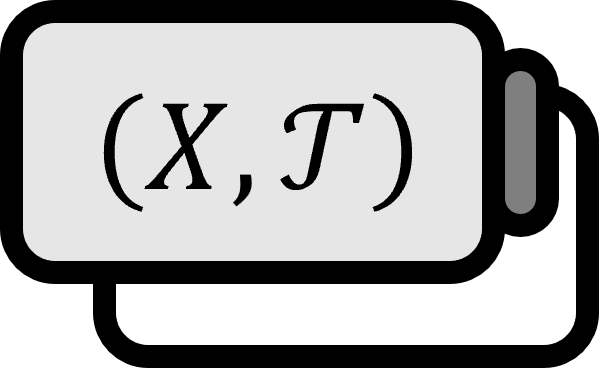Proof of the Peano Space-Filling Theorem
Theorem 1
A surjective continuous function $f : I \to I \times I$ exists for $I = [0,1]$.
Explanation
This is a short yet shockingly profound theorem. If this theorem is true, it suggests that planes can be formed solely with lines, a concept that is tough to accept even after seeing the proof. The term “Space-filling curve theorem” is arbitrarily used here, initially translated in Japan.
Proof
Part 1.
Define the sequence of paths $\left\{ f_{n} \right\}$ as shown in the following figures.

$$ f_{1} : I \to I \times I $$

$$ f_{2} : I \to I \times I $$

$$ f_{3} : I \to I \times I $$
Then, for all $x \in I$, $f_{n}$ is therefore a Cauchy sequence since $$ d ( f_{n}(x) , f_{n+1} (x) ) < {{1} \over {2^{n} }} $$
Equivalent condition for compact metric spaces: A metric space being compact is equivalent to it being complete and totally bounded.
Meanwhile, $I \times I$ being a compact metric space implies it’s a complete space, and $f_{n} (x)$ converges to some point in $I \times I$.
Let’s now define $\displaystyle f(x) : = \lim_{n \to \infty} f_{n} (x)$ as such. The proof concludes once it’s shown that $f$ is a surjective continuous function.
Part 2. $f$ is a function.
It suffices to show that for all $x \in I$, $f(x)$ exists uniquely.
- Since $I \times I$ is a complete space, Cauchy sequence $f_{n} (x)$ converges, and $f(x) \in I \times I$ always exists.
- $I \times I$ being a metric space means it’s a Hausdorff space, and $f(x)$ is unique.
Part 3. $f$ is continuous.
$f_{n}$ uniformly converging to $f$ means $f_{n}$ is continuous, so $f$ is also continuous. For a given $\varepsilon > 0$, choose $n_{0} \in \mathbb{N}$ such that it satisfies $\displaystyle {{2} \over {2^{n_{0}} }} < \varepsilon$. For all $x \in I$, $$ d ( f_{n}(x) , f (x) ) < {{1} \over {2^{n} }} $$ By the triangle inequality, $$ d ( f_{n}(x) , f (x) ) < d ( f_{n}(x) , f_{n_{0}} (x) ) + d ( f_{n_{0}}(x) , f (x) ) < {{1} \over {2^{n_{0}} }} + {{1} \over {2^{n_{0}} }} = {{2} \over {2^{n_{0}} }} < \varepsilon $$ hence $f_{n}$ uniformly converges to $f$, and $f$ is continuous.
Part 4. $f$ is surjective.
Showing that for all $y \in I \times I$, $y \in f(I)$ holds implies $f$ is surjective. Following the definition of $\left\{ f_{n} \right\}$, for a given $y \in I \times I$, $$ d(y, f_{m} (x) ) < {{ 1 } \over { 2^{m} }} $$ exists $x \in I$ and $m \in \mathbb{N}$ satisfying it. Then, for $n \ge m$, $$ d(y, f_{n} (x) ) \le d(y, f_{m} (x) ) + d(f_{m} (x) , f_{n} (x) ) < {{2} \over {2^{m}}} $$ Now, choose $n_{0} > m$ satisfying $\displaystyle {{3} \over {2^{n_{0}}}} < \epsilon$ for a given $\epsilon > 0$. By the triangle inequality, $$ d ( y , f (x) ) < d ( y , f_{n_{0}} (x) ) + d ( f_{n_{0}}(x) , f (x) ) < {{2} \over {2^{n_{0}} }} + {{1} \over {2^{n_{0}} }} = { {3} \over { 2^{n_{0} } } } < \varepsilon $$ meaning $B_{d} (y , \varepsilon ) \cap f(I) \ne \emptyset$, and for all $\varepsilon > 0$, $\displaystyle d ( y , f (x) ) < \varepsilon$, hence $y \in \overline{ f(I) }$.
Compactness and continuous functions: Let $f : X \to Y$, assuming $X$ is compact and $f$ is continuous. If $Y$ is Hausdorff, then $f$ is a closed function. For a closed set $C \subset X$, $f(C) \subset Y$ is a closed set.
Since $f$ has been shown to be continuous in Part 2., $f(I)$ is a closed set in $I \times I$, and hence $y \in \overline{ f(I) } = f(I)$. Therefore, $f : I \to I \times I$ is a surjective continuous function.
■
Munkres. (2000). Topology(2nd Edition): p272. ↩︎
